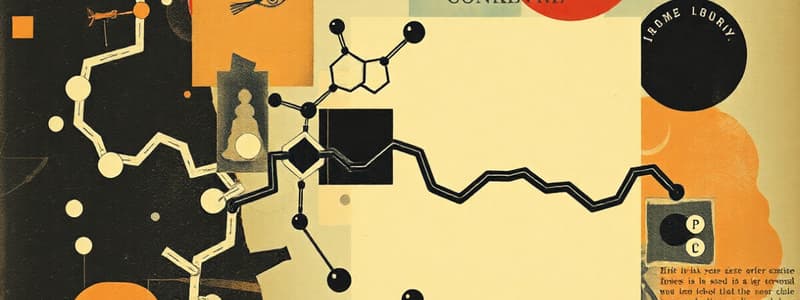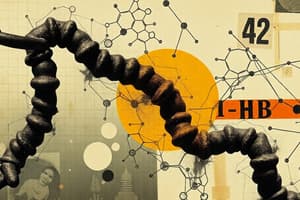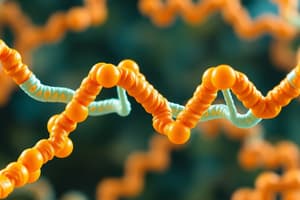Podcast
Questions and Answers
What is the primary location where glycogenesis occurs?
What is the primary location where glycogenesis occurs?
- Heart
- Skeletal muscle
- Liver (correct)
- Adipose tissue
Which substrate is primarily used for gluconeogenesis?
Which substrate is primarily used for gluconeogenesis?
- Lactate (correct)
- Fatty acids
- Amino acids (correct)
- Glucose
What is the primary product of glycolysis?
What is the primary product of glycolysis?
- Lactate
- Pyruvate (correct)
- Glucose
- Fructose
Which enzyme initiates the first step of glycogen breakdown?
Which enzyme initiates the first step of glycogen breakdown?
Which cycle involves the conversion of lactate back into glucose?
Which cycle involves the conversion of lactate back into glucose?
What is the role of glycogenin in glycogen synthesis?
What is the role of glycogenin in glycogen synthesis?
Which process converts glucose into pyruvate?
Which process converts glucose into pyruvate?
How is glycogen metabolism primarily regulated?
How is glycogen metabolism primarily regulated?
What is the primary function of the pentose phosphate pathway in erythrocytes?
What is the primary function of the pentose phosphate pathway in erythrocytes?
Which cell types are known to have the highest levels of pentose phosphate pathway enzymes?
Which cell types are known to have the highest levels of pentose phosphate pathway enzymes?
What is the consequence of the inability to maintain reduced glutathione in erythrocytes?
What is the consequence of the inability to maintain reduced glutathione in erythrocytes?
How do neutrophils and macrophages utilize NADPH generated from the pentose phosphate pathway?
How do neutrophils and macrophages utilize NADPH generated from the pentose phosphate pathway?
What histological feature is associated with the oxidation of hemoglobin due to increased peroxide accumulation in erythrocytes?
What histological feature is associated with the oxidation of hemoglobin due to increased peroxide accumulation in erythrocytes?
What is the mnemonic used to remember the nine essential amino acids?
What is the mnemonic used to remember the nine essential amino acids?
Which of the following is NOT classified as an essential amino acid?
Which of the following is NOT classified as an essential amino acid?
What structural feature is common to all amino acids?
What structural feature is common to all amino acids?
When amino acids undergo degradation, what primarily happens to them?
When amino acids undergo degradation, what primarily happens to them?
How are amino acids related to the Krebs cycle?
How are amino acids related to the Krebs cycle?
Which essential amino acid is represented by the letter 'H' in the mnemonic?
Which essential amino acid is represented by the letter 'H' in the mnemonic?
What type of bond is primarily responsible for the formation of proteins from amino acids?
What type of bond is primarily responsible for the formation of proteins from amino acids?
Which of the following amino acids is classified as a branched-chain amino acid?
Which of the following amino acids is classified as a branched-chain amino acid?
What ketone bodies are produced when beta oxidation surpasses the capacity of the Krebs cycle?
What ketone bodies are produced when beta oxidation surpasses the capacity of the Krebs cycle?
Under which conditions are ketone bodies most likely to be released into the bloodstream?
Under which conditions are ketone bodies most likely to be released into the bloodstream?
Which tissue is primarily responsible for metabolizing ketone bodies back into acetyl-CoA?
Which tissue is primarily responsible for metabolizing ketone bodies back into acetyl-CoA?
What is the primary implication of accelerated beta oxidation in the body?
What is the primary implication of accelerated beta oxidation in the body?
Which of the following scenarios would NOT typically lead to increased beta oxidation?
Which of the following scenarios would NOT typically lead to increased beta oxidation?
Which of the following statements about the relationship between beta oxidation and ketone bodies is true?
Which of the following statements about the relationship between beta oxidation and ketone bodies is true?
In uncontrolled diabetes, which metabolic pathway becomes overwhelmed, leading to high levels of ketone bodies?
In uncontrolled diabetes, which metabolic pathway becomes overwhelmed, leading to high levels of ketone bodies?
What is a primary characteristic of ketone bodies during prolonged fasting?
What is a primary characteristic of ketone bodies during prolonged fasting?
Which monosaccharide is primarily known for its role as a primary energy source in the body?
Which monosaccharide is primarily known for its role as a primary energy source in the body?
What is a characteristic feature of saponifiable lipids?
What is a characteristic feature of saponifiable lipids?
Which of the following vitamins is classified as fat-soluble?
Which of the following vitamins is classified as fat-soluble?
What is one consequence of vitamin deficiency related to water-soluble vitamins?
What is one consequence of vitamin deficiency related to water-soluble vitamins?
What role do fatty acids play in cell function?
What role do fatty acids play in cell function?
Which mineral is necessary for the proper functioning of muscles and nerves?
Which mineral is necessary for the proper functioning of muscles and nerves?
What process describes the breakdown of nucleic acids?
What process describes the breakdown of nucleic acids?
Which statement correctly describes the function of enzymes?
Which statement correctly describes the function of enzymes?
Flashcards are hidden until you start studying
Study Notes
Amino Acid Structure and Function
- Amino acids are organic compounds composed of an amino group, a carboxyl group, and a unique side chain (R group) that determines their properties.
- Peptides and proteins are formed through peptide bonds, linking amino acids via condensation reactions.
Essential Amino Acids
- Essential amino acids cannot be synthesized by the body and must be obtained from diet.
- Mnemonic ''PVT TIM HiLL'' helps recall the nine essential amino acids:
- P: phenylalanine
- V: valine
- T: tryptophan
- T: threonine
- I: isoleucine
- M: methionine
- H: histidine
- L: leucine
- L: lysine
Amino Acid Degradation
- Degradation involves the removal of amino groups to convert amino acids into intermediates like pyruvate, acetyl-CoA, or Krebs cycle intermediates.
Conversion of Amino Acids
- Amino acids can serve as substrates for the Krebs cycle, contributing to energy production and biosynthesis of key molecules.
Protein Structure and Classification
- Proteins are classified by structure: primary (sequence of amino acids), secondary (alpha helices and beta sheets), tertiary (3D shape), and quaternary (multiple polypeptides).
Carbohydrates
- Monosaccharides such as glucose, fructose, galactose, and ribose are fundamental for energy storage and metabolism.
Lipids: Classification, Structure, and Function
- Lipids include triglycerides, phospholipids, and steroids; they are essential for cell membranes, energy storage, and signaling.
- Saponifiable lipids can be hydrolyzed to yield fatty acid salts, while nonsaponifiable lipids cannot undergo this reaction.
Water-Soluble Vitamins
- Important water-soluble vitamins include B vitamins and vitamin C; deficiency leads to conditions such as scurvy and beriberi.
Fat-Soluble Vitamins
- Fat-soluble vitamins A, D, E, and K are absorbed with dietary fat; deficiencies can lead to various disorders affecting vision, bone health, and blood clotting.
Function of Minerals
- Key minerals include calcium (bone health), magnesium (energy production), sodium (fluid balance), phosphate (energy transfer), copper (iron metabolism), and potassium (muscle function).
Enzyme Function
- Enzymes are biological catalysts that accelerate biochemical reactions, lowering activation energy and increasing reaction rates.
Nucleic Acid Formation and Degradation
- DNA and RNA are formed through nucleotides; degradation involves hydrolysis, resulting in the release of nucleotides for recycling.
Glycolysis
- Glycolysis occurs in the cytoplasm, converting glucose into pyruvate with a net gain of ATP, and is regulated by key enzymes such as phosphofructokinase.
Gluconeogenesis
- The process of gluconeogenesis generates glucose from non-carbohydrate substrates, occurring primarily in the liver and regulated by hormones like glucagon.
Lactate and the Cori Cycle
- The Cori cycle converts lactate produced in anaerobic conditions back into glucose in the liver, facilitating continuous energy supply during intense exercise.
Glycogen Metabolism
- Glycogen is synthesized by adding glucose to glycogenin and broken down by glycogen phosphorylase; it is primarily stored in the liver and muscle, and helps regulate blood glucose levels.
Pentose Phosphate Pathway (PPP)
- The PPP generates NADPH for biosynthetic reactions and ribose-5-phosphate for nucleotide synthesis; it is active in tissues requiring high levels of reducing power, such as liver and immune cells.
Beta Oxidation
- Beta oxidation is the process of breaking down fatty acids in the mitochondria, producing acetyl-CoA for energy production through the Krebs cycle; it leads to the formation of ketone bodies during fasting or uncontrolled diabetes.
Studying That Suits You
Use AI to generate personalized quizzes and flashcards to suit your learning preferences.




